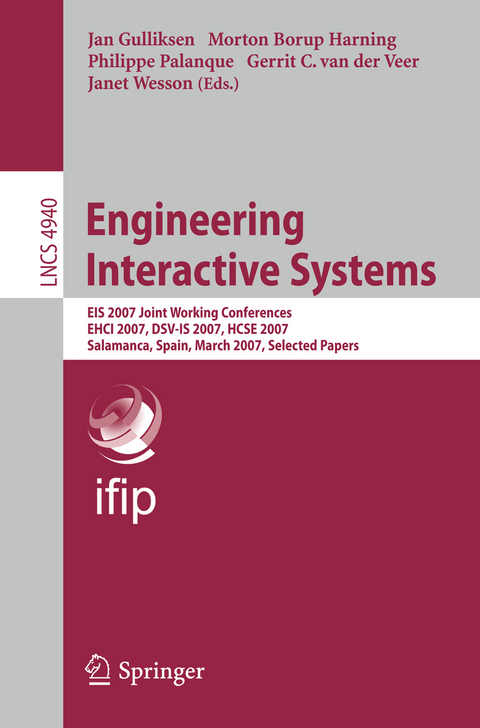Engineering Interactive Systems
Springer Berlin (Verlag)
978-3-540-92697-9 (ISBN)
Performance Analysis of an Adaptive User Interface System Based on Mobile Agents.- Combining Human Error Verification and Timing Analysis.- Formal Testing of Multimodal Interactive Systems.- Knowledge Representation Environments: An Investigation of the CASSMs between Creators, Composers and Consumers.- Consistency between Task Models and Use Cases.- Task-Based Design and Runtime Support for Multimodal User Interface Distribution.- A Comprehensive Model of Usability.- Suitability of Software Engineering Models for the Production of Usable Software.- A Model-Driven Engineering Approach for the Usability of Plastic User Interfaces.- Model-Driven Prototyping for Corporate Software Specification.- Getting SW Engineers on Board: Task Modelling with Activity Diagrams.- Considering Context and Users in Interactive Systems Analysis.- XSED - XML-Based Description of Status-Event Components and Systems.- Identifying Phenotypes and Genotypes: A Case Study Evaluating an In-Car Navigation System.- Factoring User Experience into the Design of Ambient and Mobile Systems.- Visualisation of Personal Communication Patterns Using Mobile Phones.- Integration of Distributed User Input to Extend Interaction Possibilities with Local Applications.- Reverse Engineering Cross-Modal User Interfaces for Ubiquitous Environments.- Intelligent Support for End-User Web Interface Customization.- Improving Modularity of Interactive Software with the MDPC Architecture.- Toward Quality-Centered Design of Groupware Architectures.- Programs = Data + Algorithms + Architecture: Consequences for Interactive Software Engineering.- Towards an Extended Model of User Interface Adaptation: The Isatine Framework.- Towards a Universal Toolkit Model for Structures.- Exploring Human Factors in Formal DiagramUsage.- 'Aware of What?' A Formal Model of Awareness Systems That Extends the Focus-Nimbus Model.- Service-Interaction Descriptions: Augmenting Services with User Interface Models.- A Design-Oriented Information-Flow Refinement of the ASUR Interaction Model.- On the Process of Software Design: Sources of Complexity and Reasons for Muddling through.- Applying Graph Theory to Interaction Design.- Mathematical Mathematical User Interfaces.- Coupling Interaction Resources in Ambient Spaces: There Is More Than Meets the Eye!.- Building and Evaluating a Pattern Collection for the Domain of Workflow Modeling Tools.- Do We Practise What We Preach in Formulating Our Design and Development Methods?.- Engaging Patterns: Challenges and Means Shown by an Example.- Organizing User Interface Patterns for e-Government Applications.- Including Heterogeneous Web Accessibility Guidelines in the Development Process.
| Erscheint lt. Verlag | 18.12.2008 |
|---|---|
| Reihe/Serie | Lecture Notes in Computer Science | Programming and Software Engineering |
| Zusatzinfo | XIV, 642 p. |
| Verlagsort | Berlin |
| Sprache | englisch |
| Maße | 155 x 235 mm |
| Gewicht | 991 g |
| Themenwelt | Mathematik / Informatik ► Informatik ► Betriebssysteme / Server |
| Informatik ► Software Entwicklung ► User Interfaces (HCI) | |
| Schlagworte | Adaptation • Agile modeling • Cognitive Architecture • corporate software development • Design • Design Patterns • distributed user interfaces • Efficiency • e-government applications • finite state machines • Formal Semantics • Formal Verification • Hardcover, Softcover / Informatik, EDV/Betriebssysteme, Benutzeroberflächen • HCI models • Human Computer Interaction • Human-Computer Interaction (HCI) • Intelligent • intelligent user interfaces • Interactive Systems • meta-model • mixed interactive systems • Mobile Devices • Model Checking • Model Driven Architecture • model-driven user interface design • Modeling • model transformation • multi-agent system • multimodal user interfaces • Prototyping • Quality Assessment • requirements capture • semantic web services • Software engineering • ubiquitous computing • UML • Usability • Use Cases • User Interface Design • verification • Visualisation • XML |
| ISBN-10 | 3-540-92697-6 / 3540926976 |
| ISBN-13 | 978-3-540-92697-9 / 9783540926979 |
| Zustand | Neuware |
| Haben Sie eine Frage zum Produkt? |
aus dem Bereich




